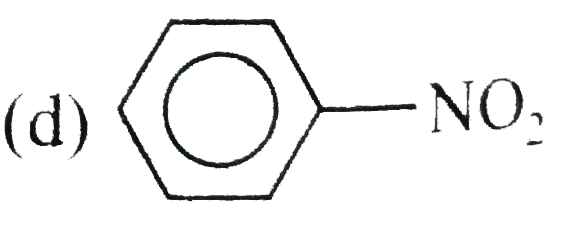Propanamide Br2−−→KOHA(i)HNO2−−−−−−−−→(ii)RedP,HIB, here [B ] is :
N-ethyl acetamide
Propane
Ethane
Acetone
The correct Answer is:C
To solve the question step by step, let's break down the reactions involved:
Step 1: Reaction of Propanamide with Bromine and KOH
1. Identify Propanamide: The structure of propanamide is C2H5C(=O)NH2.
2. Hofmann Bromamide Degradation: When propanamide reacts with bromine (Br2) in the presence of potassium hydroxide (KOH), it undergoes Hofmann degradation. This reaction involves the following steps:
- The nitrogen of the amide is deprotonated by the base OH−, forming a negatively charged nitrogen species.
- This negatively charged nitrogen attacks the bromine molecule, leading to the formation of bromamide.
- The bromamide then loses a carbon atom, resulting in the formation of an amine with one carbon less than the original amide.
3. Formation of A: After the Hofmann degradation, we get ethylamine (C2H5NH2) as compound A.
Step 2: Reaction of A (Ethylamine) with HNO2
1. Reaction with HNO2: Ethylamine reacts with nitrous acid (HNO2), which can be represented as HONO.
- The nitrogen of the amine (NH2) is protonated by HNO2, forming a diazonium ion intermediate (C2H5N+2).
- The diazonium ion then decomposes, releasing nitrogen gas (N2) and forming a carbocation (C2H+5).
- The carbocation then reacts with water to form ethanol (C2H5OH).
2. Formation of Ethanol: After this reaction, we have ethanol as compound B.
Step 3: Reaction of Ethanol with Red Phosphorus and HI
1. Reaction with Red Phosphorus and HI: Ethanol reacts with red phosphorus and hydroiodic acid (HI).
- Red phosphorus and HI act as reducing agents, converting the alcohol into an alkane.
- The reaction leads to the formation of ethane (C2H6) and water.
2. Final Product B: Thus, the final product B is ethane (C2H6).
Final Answer
The structure of compound B is ethane (C2H6).
---
1. Identify Propanamide: The structure of propanamide is C2H5C(=O)NH2.
2. Hofmann Bromamide Degradation: When propanamide reacts with bromine (Br2) in the presence of potassium hydroxide (KOH), it undergoes Hofmann degradation. This reaction involves the following steps:
- The nitrogen of the amide is deprotonated by the base OH−, forming a negatively charged nitrogen species.
- This negatively charged nitrogen attacks the bromine molecule, leading to the formation of bromamide.
- The bromamide then loses a carbon atom, resulting in the formation of an amine with one carbon less than the original amide.
1. Reaction with HNO2: Ethylamine reacts with nitrous acid (HNO2), which can be represented as HONO.
- The nitrogen of the amine (NH2) is protonated by HNO2, forming a diazonium ion intermediate (C2H5N+2).
- The diazonium ion then decomposes, releasing nitrogen gas (N2) and forming a carbocation (C2H+5).
- The carbocation then reacts with water to form ethanol (C2H5OH).
1. Reaction with Red Phosphorus and HI: Ethanol reacts with red phosphorus and hydroiodic acid (HI).
- Red phosphorus and HI act as reducing agents, converting the alcohol into an alkane.
- The reaction leads to the formation of ethane (C2H6) and water.
The structure of compound B is ethane (C2H6).
Similar Questions
Knowledge Check
- Question 1 - Select One
Which A gives red colour in the reaction
A(i)HNO2−−−−−−−−→(ii)NaOH red colur ?ACH3CH2NO2B(CH3)2CHNO2C(CH3)2CHO2D .
. - Question 2 - Select One
Ph−CH2−CH=CH−CH3(i)Br2−−−−−−−−→(ii)Alc.KOH
APh−CH=CH−CH=CH2BPh−CH2−CH∣OH−CH∣OH−CH3CPh−CH2−C≡C−CH3DPh−C≡C−CH2−CH3 - Question 3 - Select One
CH3CH2COOHBr2−−→red PABr2−−→B
What is B?ACH3CH2BrBCH3CH2CHOCCH3−C∣BrH−COOHDBr−CH2−CH2−COOH
In the following reaction order , B is
CH3CH2COOHP/Br2−−−→AalcKOH−−−−→H+BView SolutionCH3CH2COOHCL2−−→RedP(A)Alc.KOH−−−−−→(B)
What is (B)?View SolutionThe correct set of the products obtained in the following reactions :
(A)RCNreduction −−−−−−→(B)RCN(i)CH3MgBr(ii)H2O
(c)RNC hydrolysis −−−−−−−→(D)RNH2HNO2−−−→
the correct answer is :View SolutionPhCOOMe(A)(i)NH2OH−−−−−−−−−→(ii)ӨOH(iii)EtOH(B)
Product (B) is :View SolutionCH3CH2COOHCl2−−→red PAalc KOH−−−−→B
What is B?View Solution

